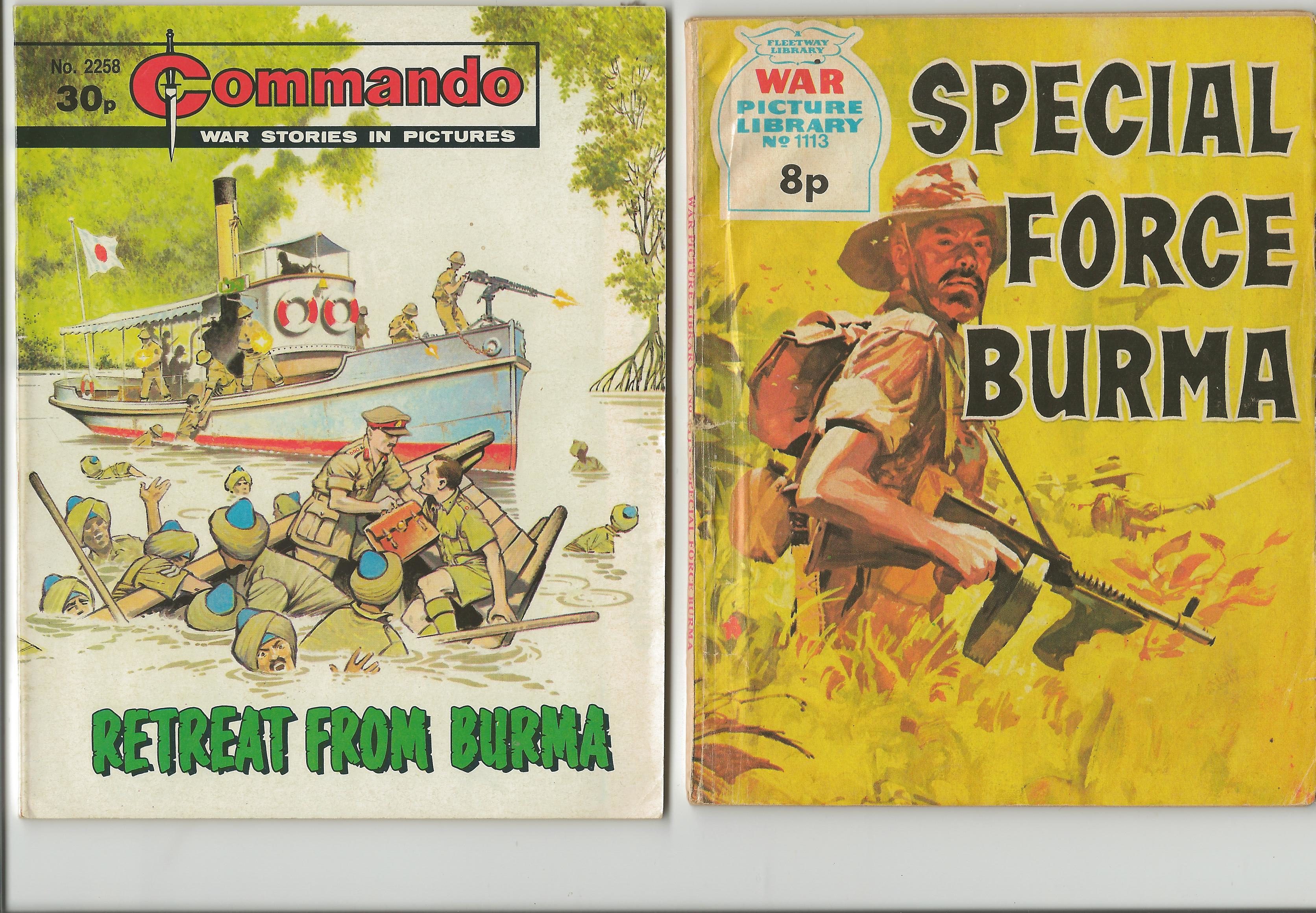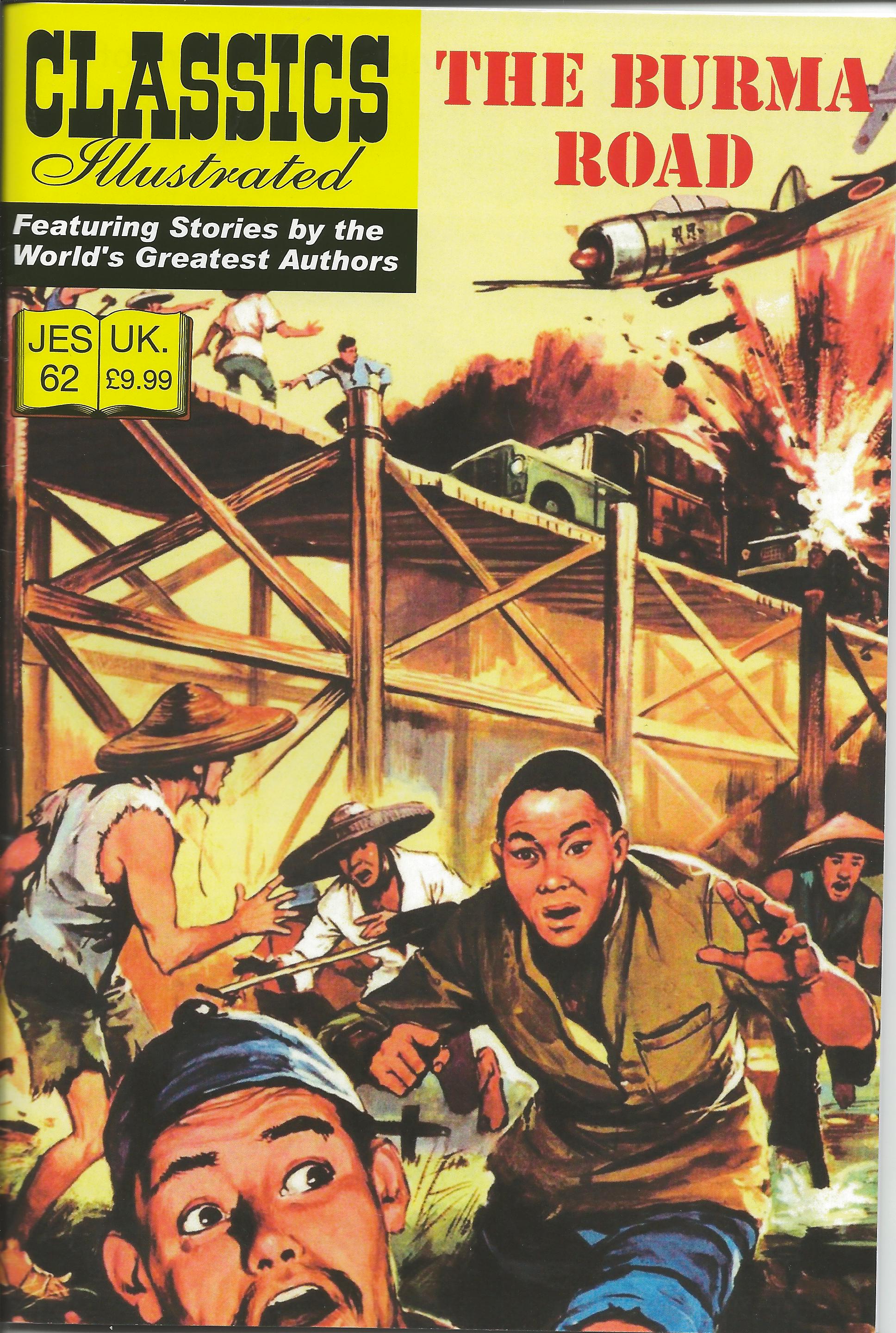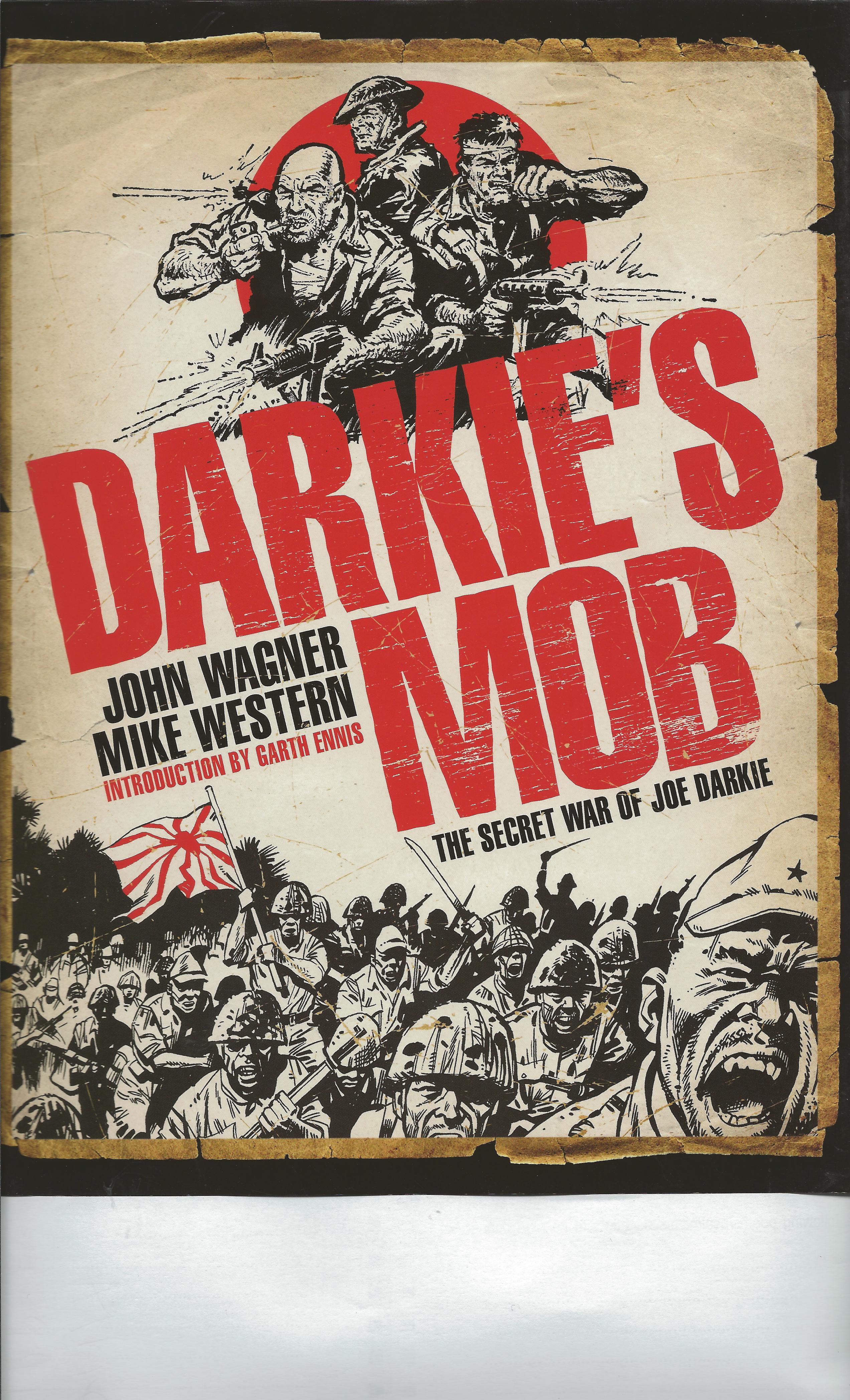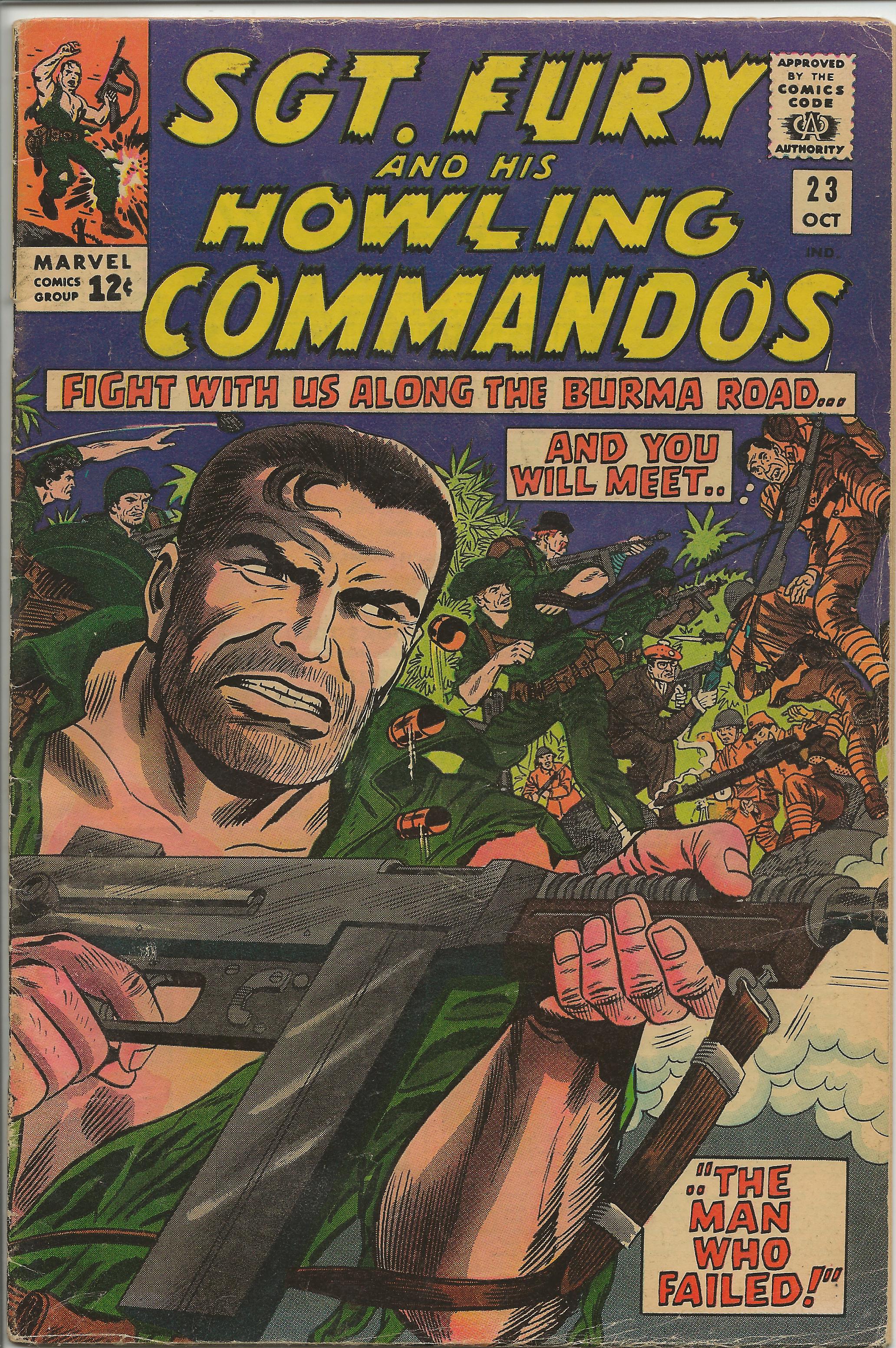World War 2 Comic Book Once Again
In the kickoff of a ii-part series, Andrew Selth explores the relationship between conflict and comics in yesterday's Myanmar.
In his 2011 study, British Comics, James Chapman wrote that comic books were 'a valuable but neglected source of social history that provided insights into the societies and cultures in which they were produced and consumed'. Like other forms of popular visual culture, such as movies, comics are non only a reflection of the tastes and social values of consumers, just also play an important function in influencing their attitudes and behaviours. Chapman went on to land; 'The fact that the main consumers of comics have been children brand them an even more stiff form of pop culture'.
In this regard, George Orwell'southward views remain pertinent. In an essay on 'Boys' Weeklies' showtime published in 1940 he wrote that:
Most people are influenced far more than they would intendance to admit by novels, serial stories, films and so forth, and from this indicate of view the worst books are often the about of import because they are unremarkably the ones that are read earliest in life. It is probable that many people who consider themselves extremely sophisticated and 'advanced' are actually carrying through life an imaginative background which they acquired in babyhood.
Orwell was writing about children'southward story papers like Gem (1907-39) and Magnet (1908-40), but his comments could utilize equally to comics.

With these thoughts in mind, it might be instructive to survey the development of comic books in key English-speaking countries and to look at the mode in which Burma (formally known after 1989 equally Myanmar) has been depicted in them.
Comics tin be traced back to the 19th century and the use of cartoons, usually consisting of a single panel and caption, to amuse and inform adult audiences. These illustrations developed into sequential frame-enclosed pictures with captions and speech balloons. By the early 20th century, comic 'strips' were a regular feature of most major newspapers. The first mod comic book, Famous Funnies, was released in the United states of america in 1933. While read past adults, they were aimed mainly at juveniles. The name 'comic' derived from their original satirical and humorous content, but they embraced a wide range of subjects.
Earlier World War II, most British comics were 'funnies' meant for immature children, only in the US they tended to focus more on action and adventure stories for older readers. In 1938, Superman made his debut in Activeness Comics, followed a year later by Batman in Detective Comics. These and other costumed superheroes became enormously pop, profoundly boosting sales. They fabricated comic books a major arm of the global publishing industry, specially during their 'gold age', generally taken to be from 1938 to 1954.
References to Burma in Western comic books have been linked to events in the country, topical bug in the wider world and, to a lesser extent, popular literature.
 The first mention of Burma appears to take been in 1938. In the The states that year, Detective Comics reproduced a 1930-31 newspaper comic strip based on Sax Rohmer's novels about the Chinese curvation-villain Dr Fu Manchu. Both the strip and comic book referred to Fu Manchu'southward Burma connections and those of his nemesis, erstwhile Police Commissioner Sir Denis Nayland Smith. However, it was the construction of the Burma Road from Lashio to Kunming, begun in 1937, and the invasion of Burma by Nippon in December 1941 that prompted its depiction in comic books. Once more, United states of america publishers led the way.
The first mention of Burma appears to take been in 1938. In the The states that year, Detective Comics reproduced a 1930-31 newspaper comic strip based on Sax Rohmer's novels about the Chinese curvation-villain Dr Fu Manchu. Both the strip and comic book referred to Fu Manchu'southward Burma connections and those of his nemesis, erstwhile Police Commissioner Sir Denis Nayland Smith. However, it was the construction of the Burma Road from Lashio to Kunming, begun in 1937, and the invasion of Burma by Nippon in December 1941 that prompted its depiction in comic books. Once more, United states of america publishers led the way.
In 1941, a Grit Grady comic placed its eponymous hero in Rangoon, where he was recruited by a mysterious woman to run guns to Chiang Kai-shek'due south Nationalist Chinese forces. In 1942, Activeness Comics sent the adventurer Congo Bill to ferry supplies up the Burma Road. Pat Patriot, who was billed as 'America's Joan of Arc', spent most of her time protecting the home front end. Withal, in her last take a chance she went to Burma with 100 female soldiers (all wearing skirts and high heels) to railroad train the 'slack, slovenly and unmilitarised' Chinese troops guarding the Burma Road (Daredevil Comics, 1942).
The comic strip (and subsequently books) Terry and the Pirates, created by Milton Caniff in 1934, described the adventures of a soldier of fortune in the 'Far East'. After the outbreak of World War Two, Terry joined the U.s.a. air force and the action revolved around an air base in southern China, like to that operated by the 'Flying Tigers' American Volunteer Grouping in 1941 and 1942. A major character in the comic was a sultry and morally ambiguous blonde woman named 'Burma'. Caniff was widely praised for his realistic and sympathetic portrayal of military life in the Red china-Burma-India (CBI) theatre.
Other American comic volume characters were recruited to assist the war effort. In 1942, for example, the Strange Twins featured in a story entitled 'The Burma Route Bombers'. In a 1943 Action Comics story entitled 'Burma Remembers', Tex Thompson (known to his fans as Americommando) was sent to destroy a Japanese prophylactic stockpile. Also that twelvemonth, the air ace Spin Shaw was shot down over Burma and underground agent Jane Martin was sent to Rangoon to expose a Japanese spy ring. At the same time, 'The Black Venus', a former exotic dancer turned fighter pilot, who favoured tight leather bodysuits, earned her reputation as the 'Terror of the Burma Skies'.
In 1944, Quality Comics published 'Bait for a Death Trap', in which the intrepid airplane pilot known as Blackhawk was based in Burma's Shan hills. After existence shot downward, he was about to be executed past the Japanese when he was rescued by a bull elephant trained by 'Burma Jack', 'a bearded rascal, formerly an elephant dealer and at present a soldier of fortune'. Jack's houseboys referred to him by the hybrid Hindi/Burmese term, 'Burra Thakin'. After appearing to beguile Blackhawk and two other members of his squadron to the Japanese, Burma Jack reveals himself to be an undercover British intelligence officer.
During World War II, millions of comic books were printed each month. The United states government considered them critical to the morale of the fighting forces. They were also powerful propaganda tools, depicting superheroes like Captain America, and 'bodily people and events'. The latter category included stories about Burma, such every bit 'Wingate's Raiders' (American Library, 1943) and 'Merrill'south Marauders' (Real Life Comics, 1944). Fifty-fifty after the war ended there were stories like 'The Secret Warriors', which described how the Office of Strategic Services (which became the CIA) trained an army of '250,000 monkey-eating Kachins' (True Comics, 1946).
 In the mid-1950s, the Joint European Series of Classics Illustrated comics (which were written in High german, Swedish and Dutch) published 'The Burma Road'. In a fictionalised but reasonably authentic account, it traced the route'southward history from the Mongol invasion of Burma in the 13th century to the end of Globe War II. It is unclear why this title was not issued every bit part of the chief Classics series (1941-71), which was very popular in the United states, Britain and countries like Australia. Nonetheless, in the 1980s the comic was translated into English, and reissued with the original artwork.
In the mid-1950s, the Joint European Series of Classics Illustrated comics (which were written in High german, Swedish and Dutch) published 'The Burma Road'. In a fictionalised but reasonably authentic account, it traced the route'southward history from the Mongol invasion of Burma in the 13th century to the end of Globe War II. It is unclear why this title was not issued every bit part of the chief Classics series (1941-71), which was very popular in the United states, Britain and countries like Australia. Nonetheless, in the 1980s the comic was translated into English, and reissued with the original artwork.
The war in Burma connected to exist a rich source of material for the comic industry. The style that it was portrayed, however, varied between British and American products. At the chance of over-generalising, the one-time tended to be more restrained and factually accurate. Stories in War Pic Library (1958-84), Air Ace (1960-70) and Commando (1961-nowadays), for case, were frequently written and drawn by British veterans. Some had served in the CBI theatre. They too drew on historical records for greater authenticity. Their descriptions of gainsay in Burma were thus (within obvious limits) quite apparent.
These comics depicted Burma in anticipated terms. Sixty-four page stories like 'Soldier of Burma', 'Special Forces Burma', 'Gliders Over Burma' and 'Escape From Burma' gave aplenty scope for writers and artists to describe the country'south rugged terrain, lush tropical vegetation, exotic fauna and farthermost weather. Favourite themes were the trials of special units like the Chindits and efforts by downed RAF pilots to return overland to India. Pro-Allied ethnic groups like the Karen, Kachin and Naga were treated sympathetically, while the Japanese were about always depicted as ruthless fanatics.

In US state of war comics, by dissimilarity, the plots involving Burma tended to be more far-fetched, the action more farthermost, the dialogue more improbable and the heroes less believable. Warfront Comics (1951-67), for example, trumpeted the exploits of the 'Lone Tiger', who flew solo fighter missions against the Japanese. 'Sergeant Fury and his Howling Commandos' (Curiosity Comics, 1963-81), wreaked mayhem along the Burma Road while 'Captain Savage and his Leatherneck Raiders' (Curiosity Comics, 1968-70) conducted equally unlikely operations. In a 1971 comic, 'The Losers' escaped a tiger and trekked through Burma'southward 'dense fetid jungle' to attack a Japanese base, helped by an elephant.
Past the 1980s, a more relaxed censorship authorities and an appetite for uncompromising detail had blurred some of the distinctions betwixt British and American war comics. This was demonstrated by Boxing Picture Weekly, which was published in United kingdom of great britain and northern ireland from 1975 to 1988. It was perhaps best known for a series produced in the mid-1970s entitled 'Darkie'southward Mob', in which the tormented (indeed, most psychotic) anti-hero moulded a squad of dispirited men into 'the most savage fighting force the Japanese [in Burma] have ever known'. In 2011, the stories were collected and reissued as a graphic book.
Comic books with a Burma theme, however, accept non been confined to stories almost gung-ho heroics during Globe War 2. The country has also provided a setting for much lighter fiction, fantasies and foolishness.
To be continued…
Andrew Selth is Adjunct Associate Professor at the Griffith Asia Found, Griffith University, and at the Coral Bell Schoolhouse of Asia Pacific Diplomacy, Australian National University.
A related article by Andrew Selth, on colonial Burma in pulp fiction, was published in Nikkei Asian Review on 11 July 2016.
butterworthspon1968.blogspot.com
Source: https://www.newmandala.org/burma-comics-wars-rumors-wars/
0 Response to "World War 2 Comic Book Once Again"
Post a Comment